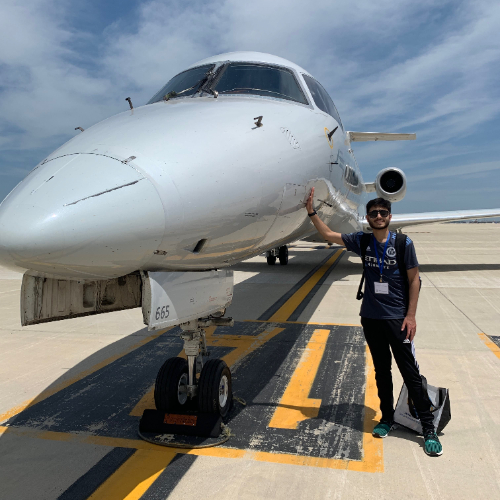When we think of supersonic travel, we immediately think of aircraft like the Concorde and various types of fighter jets. That's because these aircraft were built to regularly fly at supersonic speeds.
But what if I told you that a Boeing 747 once went supersonic? Believe it or not, this happened back in 1991 and that's what we will be discussing today.
Supersonic 747
This insane event took place on December 12th, 1991, and involved an Evergreen International Airlines Boeing 747-100F registered N475EV.
.jpg)
N475EV was built in 1970 and was the third Boeing 747 to roll off the assembly line. It initially flew for Pan Am before being converted to a freighter for Evergreen.
On that day, the 747 was flying from New York Kennedy (JFK) to Tokyo Narita (NRT) with a stopover in Anchorage, Alaska (ANC). Six crew members were the only occupants onboard the flight.
At about 5:20 a.m. Central Time, while cruising at 31,000 ft over Canada, the flight crew noticed that the aircraft's Inertial Navigation System (INS) "FAIL" lights were on.
While checking their instruments, they realized that the plane had entered a 90-degree right bank and was descending at an angle of 30 to 35 degrees.

The descent was rather rapid, meaning the 747 was quickly losing altitude and gaining speed too.
Such a quick descent meant that the aircraft had already lost over 10,000 feet before the pilots could regain control. The three pilots operating the flight were able to stabilize the plane at 25,000 ft.
Just 23 or so minutes after the issue presented itself, the 747 safely made an emergency landing in Duluth, Minnesota (DLH) and all occupants onboard were unharmed.
The plane was inspected after it arrived in Duluth. A large hole measuring roughly three feet by 15 feet (or 0.9 meters by 4.5 meters) was found in the leading edge of the right wing, inboard of the Number 3 engine.
,_Evergreen_International_Airlines_AN0827397.jpg)
Specifically, this means that the hole was found on the front edge of the right wing, in the area that stretches between the Number 3 engine and the fuselage.
It was revealed that three sheet metal panels had been sheared off. They had then struck the right horizontal stabilizer and dented the leading (front) edge of it.
Furthermore, one of the flaps on the left wing had fallen off while the plane landed in Duluth.
While the exact cause for the hole and fuselage damage was never specified, it was this reason that caused the 747 to enter the rapid descent.
,_Evergreen_International_Airlines_AN0386924.jpg)
This descent resulted in the 747-100 exceeding its maximum capable speed limit of Mach 0.92. The exact speed was never found but official reports suggest that the plane reached at least Mach 0.98 during its rapid descent. Some reports even indicate that it went as fast as Mach 1.25, putting it beyond the supersonic speed limit.
The National Transportation Safety Board (NTSB) did not confirm speeds higher than 0.92. However, Boeing made statements suggesting that the plane went supersonic in the past.
According to The Chicago Tribune in 1992, a Boeing spokesperson had noted the following:
"Original flight tests of 747s conducted in 1969 and 1970 took 747-100 models to speeds of Mach 0.99. In addition, Boeing knows one case in which a 747 operated by Evergreen International made an emergency descent at speeds that exceeded Mach 1."
Subsonic 747s?
Following the incident, N475EV was repaired and returned to service. It was later re-registered to N615FF and flew cargo for Tower Air and Kalitta Air before being scrapped sometime after 2005.
The airline, officially known as Evergreen International Aviation, went bankrupt and shut down in 2014.

While no 747 has gone supersonic since the incident in 1991, one notable speed-related incident occurred in 2020 involving the plane.
On February 9th, 2020, British Airways Flight 112 from New York (JFK) to London Heathrow (LHR) made its trans-Atlantic crossing in a record four hours and 56 minutes. This remains the fastest Atlantic crossing ever done by a subsonic aircraft.
The aircraft was G-CIVP, a Boeing 747-400. Storm Ciara was thrashing the United Kingdom and nearby areas at the time and was unleashing tailwinds up to 200 miles per hour.
These tailwinds brought the 747-400 to a peak ground speed of 825 miles per hour. While that is technically supersonic speed (the threshold is 768mph), the aircraft's peak airspeed remained subsonic at roughly Mach 0.85.
Bomb Threat Cancels Air New Zealand Flight, Delays Passengers » Thousands of Flights Impacted as Winter Storm Blair Hits U.S. » Could You Survive a Plane Crash? The Unlikely Science of Plane Crash Survival »
Comments (0)
Add Your Comment
SHARE
TAGS
INFORMATIONAL SupersonicSupersonic PlanesEvergreen AirlinesBoeing 747747-100747-400Aviation History747 SupersonicSupersonic 747RECENTLY PUBLISHED
 Could You Survive a Plane Crash? The Unlikely Science of Plane Crash Survival
With air travel consistently being heralded as the safest form of public transport, most of us do not board a plane pondering our chances of survival in the event of a crash. But, is it possible to survive one?
INFORMATIONAL
READ MORE »
Could You Survive a Plane Crash? The Unlikely Science of Plane Crash Survival
With air travel consistently being heralded as the safest form of public transport, most of us do not board a plane pondering our chances of survival in the event of a crash. But, is it possible to survive one?
INFORMATIONAL
READ MORE »
 Maldivian Airlines Introduces First-Ever Widebody Aircraft, Plans New China Flights
Maldivian, the government-owned national airline of the Maldives, has just welcomed its first-ever wide body aircraft: the Airbus A330-200. With the new aircraft, the carrier also plans brand-new long haul international flights to China.
NEWS
READ MORE »
Maldivian Airlines Introduces First-Ever Widebody Aircraft, Plans New China Flights
Maldivian, the government-owned national airline of the Maldives, has just welcomed its first-ever wide body aircraft: the Airbus A330-200. With the new aircraft, the carrier also plans brand-new long haul international flights to China.
NEWS
READ MORE »
 Thousands of Flights Impacted as Winter Storm Blair Hits U.S.
Winter Storm Blair has unleashed a huge blast of snow, ice, and freezing temperatures across the Central and Eastern United States.
As of Sunday afternoon, over 6,700 flights and counting have been disrupted. This includes cancelations and significant delays leaving passengers scrambling to change flights and adjust travel plans.
NEWS
READ MORE »
Thousands of Flights Impacted as Winter Storm Blair Hits U.S.
Winter Storm Blair has unleashed a huge blast of snow, ice, and freezing temperatures across the Central and Eastern United States.
As of Sunday afternoon, over 6,700 flights and counting have been disrupted. This includes cancelations and significant delays leaving passengers scrambling to change flights and adjust travel plans.
NEWS
READ MORE »



,_Evergreen_International_Airlines_AN0362115.jpg)

